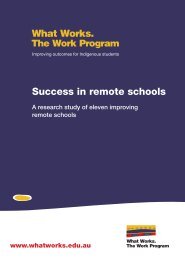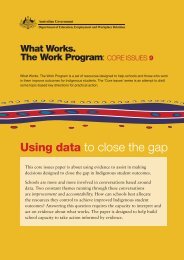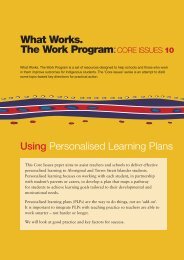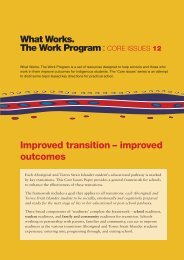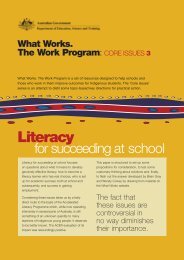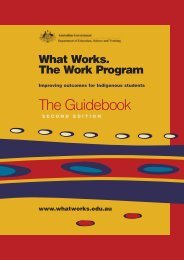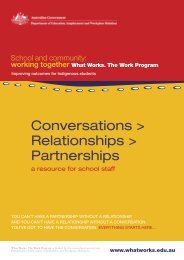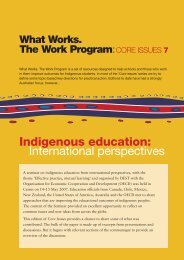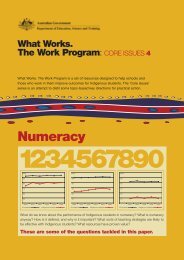How to use <strong>Scope</strong> <strong>and</strong> <strong>Sequence</strong> <strong>Statements</strong>IntroductionTeaching is a complex craft. Whereas once teaching involved reading a document which outlined what had to be taught<strong>and</strong> then teaching this content in ways that we were familiar with <strong>and</strong> that had worked <strong>for</strong> us, it now involves makingcomplex decisions, during the initial planning stages, as each lesson progresses, <strong>and</strong> at the conclusion of each lesson <strong>and</strong>group of lessons.This change has come about largely as a result of what research has revealed in the past 20-30 years about how childrenlearn <strong>and</strong> about what in fact they learn <strong>and</strong> don’t learn as a result of the teaching they are exposed to. It is also a result ofa greater degree of close public scrutiny of what occurs in classrooms <strong>and</strong> an increased dem<strong>and</strong> by the public <strong>for</strong> teachersto be accountable <strong>for</strong> the learning of their children.There are many factors that influence the learning of students in our classrooms <strong>and</strong> many of these are external factorsbeyond the control of teachers <strong>and</strong> schools. Teachers can only be held accountable <strong>for</strong> presenting every student with anappropriate curriculum. It is in deciding how to do this to best meet the needs of every student that sets the craft ofteaching apart as a profession.Features of the <strong>Scope</strong> <strong>and</strong> <strong>Sequence</strong> <strong>Statements</strong>The sequencesThe sequences have been written to cover 10 years of schooling from year 1 through to year 10. It is essential thatstudents have multiple opportunities to learn – <strong>and</strong> as a result to know, underst<strong>and</strong> <strong>and</strong> be able to do, what is describedunder each year heading by the end of the indicated year of schooling. In particular, the learning descriptions outlinewhat is essential <strong>for</strong> students to know, underst<strong>and</strong> <strong>and</strong> be able to do by the end of years 3, 5, 7, <strong>and</strong> 9 <strong>and</strong> are critical <strong>for</strong>future learning <strong>and</strong> progress. The learning descriptions <strong>for</strong> years 1, 2, 4, 6, 7, <strong>and</strong> 8 provide essential scaffolding <strong>for</strong>learning required by the end of year 3, 5, 7 <strong>and</strong> 9 respectively.The fact that the sequences have been written to cover 10 years of schooling from year 1 through to year 10, does notmean that students cover what is written under each year heading during the school year in which they are enrolled.The learning descriptions indicate what students are expected to be able to do, know <strong>and</strong> underst<strong>and</strong> by the end of theindicated year. It is likely however, that some students will begin the year <strong>and</strong> already be able to do what is described thatthey should be able to do by the end of the school year. These students should not be held back <strong>and</strong> made to repeat thiswork but should be given opportunities to both consolidate their learning <strong>and</strong> progress onto what it described underfollowing year(s). Similarly, if students enter a schooling year <strong>and</strong> it becomes obvious to the classroom teacher that theyare unable to do, know <strong>and</strong> underst<strong>and</strong> what they should have been able to do by the end of the previous year, theyshould be given multiple opportunities to revisit this work so that they don’t get further behind. It is inappropriate, <strong>for</strong>example, <strong>for</strong> a student to be taught, without scaffolding, what is described under ‘year 4’ if they do not know orunderst<strong>and</strong> what is described as essential under ‘year 3’ in the sequence.In summary, it is essential that students who are not able to access the learning presented under each year heading in the<strong>Scope</strong> <strong>and</strong> <strong>Sequence</strong> are given scaffolding to do so using what is described under previous year headings. Similarly it isessential that students who are already able to do, know <strong>and</strong> underst<strong>and</strong> what is described <strong>for</strong> the school year in whichthey are enrolled, are given opportunities to progress through subsequent years at a rate appropriate <strong>for</strong> them.The learning descriptionsThe learning descriptions that make up the sequences are student-centred. This means that they describe what the studentshould be able to do as a result of the learning opportunities <strong>and</strong> environments created <strong>and</strong> presented to them by theteacher. They do not describe what the teacher teaches, but rather the learning that the student should demonstrate as aresult of what is presented/taught by the teacher.This approach will be new <strong>for</strong> many teachers. It requires teachers to focus on the learning rather than the teaching. Howto do this is explained below.Curriculum Consistency Outcomes, <strong>and</strong> what is likely to be included in the Queensl<strong>and</strong> Curriculum Assessment <strong>and</strong>Reporting Framework (QCARF).Many of the KLAs have an identified process str<strong>and</strong>. These include Working Mathematically in Mathematics, WorkingScientifically in Science, Technology Process in Technology, Inquiry in Studies of Society <strong>and</strong> Environment, <strong>and</strong> Create-Present-Respond in the Arts. It is essential that these processes, or ways of working, are embedded in the learning of theknowledge, skills <strong>and</strong> underst<strong>and</strong>ings of the content str<strong>and</strong>s of the KLAs. It would be inappropriate <strong>for</strong> example, to teachthe content of Number in Mathematics without simultaneously Working Mathematically, or In<strong>for</strong>mation in Technologywithout simultaneously using the Technology Process, or Drama without attending to Create-Present-Respond in TheArts. Focussing on the process str<strong>and</strong>s will support students’ literacy learning <strong>and</strong> enable students to use the contentknowledge <strong>and</strong> underst<strong>and</strong>ings they have learned in other contexts both within <strong>and</strong> beyond the school environment.Some important principles1. High expectationsWe must assume that every child can <strong>and</strong> will be able to know, do <strong>and</strong> underst<strong>and</strong> what is written in the statementsby the end of the indicated year of schooling <strong>and</strong> that many will know, do <strong>and</strong> underst<strong>and</strong> well beyond this. It isinappropriate to decide that any student will ‘never be able to….’.Research has shown that the majority of students who are unable to learn what is being presented/taught in aclassroom have simply not had sufficient scaffolding <strong>for</strong> them to access it. The <strong>Scope</strong> <strong>and</strong> <strong>Sequence</strong> documentsprovide the scaffolding so that the teacher can ‘go back’ along the sequence to what the child does know <strong>and</strong>underst<strong>and</strong> <strong>and</strong> move them <strong>for</strong>ward from that point.We have a fundamental belief that all children are able to learn to levels well beyond our highest expectations.2. Don’t assume anythingIt is inappropriate to assume that a student knows something or is able to do something merely because they havepreviously been taught it. For many students there is a wide gap between what has been taught <strong>and</strong> what has beenlearned. It is the role of the classroom teacher to support every student to learn what is critical. This may meanteaching <strong>and</strong> presenting the same concepts <strong>and</strong> skills in multiple <strong>and</strong> various ways in order to give every studentaccess through their preferred learning styles.3. Multiple opportunities to learnAll students must have multiple opportunities to learn what is indicated in the learning descriptions. This does notnecessarily mean they should be taught them repeatedly. It means that they should be immersed in a teaching <strong>and</strong>learning environment that facilitates the learning of these knowledges, skills <strong>and</strong> underst<strong>and</strong>ings. They might bepresented through a variety of pedagogical approaches including explicit teaching, tasks, activities, group challenges<strong>and</strong> presentations. These clearly cannot occur in one sitting but should occur over a period of time <strong>and</strong> in differentcontexts. They could also occur at spaced intervals throughout the year. This might mean that students who mayalready have learned can more deeply consolidate their learning, others might refine their learning, while othersmight learn <strong>for</strong> the first time as a result of more appropriate scaffolding.Using the <strong>Scope</strong> <strong>and</strong> <strong>Sequence</strong> learning descriptions to planThe learning descriptions describe what the student does as a result of the learning opportunities <strong>and</strong> environments thatthe teacher presents to them. Hence, they describe the outcome of the learning process:INPUT OUTCOMEThe Key Learning Areas (KLAs)The <strong>Scope</strong> <strong>and</strong> <strong>Sequence</strong>s have been organised using seven KLAs: English, Mathematics, Science, Studies of Society<strong>and</strong> Environment, The Arts, Health <strong>and</strong> Physical Education, <strong>and</strong> Technology. The statements that describe what isessential learning in the <strong>Scope</strong> <strong>and</strong> <strong>Sequence</strong>s address what is critical from the Queensl<strong>and</strong> Syllabuses, the NationalLearning opportunitiespresented by teacherresulting inLearning Description ofwhat the student knows,underst<strong>and</strong>s, is able to do<strong>Bound</strong> <strong>for</strong> <strong>Success</strong> <strong>Scope</strong> <strong>and</strong> <strong>Sequence</strong> <strong>Statements</strong> V2 Page 1 Working Document Semester One 2007
How to use <strong>Scope</strong> <strong>and</strong> <strong>Sequence</strong> <strong>Statements</strong>Hence, in order to plan a lesson or series of lessons, the following procedure should occur:1. Read the learning description <strong>and</strong> underst<strong>and</strong> exactly what the learning is that is described; what is it that you wantthe student to know, underst<strong>and</strong> <strong>and</strong> be able to do, as a result of what you do. (Note, beware of placing your owninterpretation on the description. It is important that you read the description in an holistic way – do not focus onindividual words or content that is familiar to you at the expense of the processes in the description. If unsure consulta colleague or group of colleagues).2. Make some decisions about what you will need to teach/present in order that the student demonstrates their learningas indicated in the learning description. (You will need to ensure that students have learned what is described in thescaffolding <strong>for</strong> previous years that precedes the description. If not, you may need to revisit these). There may be anumber of different things you might need to teach as parts of the description be<strong>for</strong>e addressing the description in anholistic way. This will ensure the learning is scaffolded.3. Consider how you might teach <strong>and</strong> present the content <strong>and</strong> processes. Remember that students in your class willhave a variety of different learning styles so you will need to use a range of pedagogical strategies in order tomaximise the learning opportunities <strong>for</strong> each student. You might teach through an activity, use some explicit didacticteaching, support students to do some investigatory research, <strong>and</strong>/or use a combination of these <strong>and</strong> otherapproaches.4. Consider how you might decide whether your students know, underst<strong>and</strong> <strong>and</strong> can do what is presented in thelearning description. In other words, if this is a description of the learning that you require, how will you give yourstudents the opportunity to demonstrate this learning? This might be described as ‘assessing the learning’ or‘gathering evidence of learning’. If students are unable to demonstrate the learning you require as indicated in thelearning description, you will need to plan <strong>for</strong> <strong>and</strong> provide further opportunities <strong>for</strong> the learning to occur.1. What do I wantmy students toknow, do <strong>and</strong>underst<strong>and</strong>?2. What will Ineed to teach/present <strong>for</strong> themto demonstratethis learning?4. How will I assess tofind out whether theyhave learned it or not?3. How will I teach tomaximise theopportunities <strong>for</strong> allstudents to learn what Iwant them to learn?These complex decisions must be made by every classroom teacher as part of the planning process <strong>for</strong> every lesson <strong>and</strong>group of lessons. The process focuses on the desired student learning, not on the teaching. It is this complexity, based onan assumption that the classroom teacher is the person best-placed to know each student that they teach (that is, whatthey know, underst<strong>and</strong> <strong>and</strong> can do as well as their preferred learning styles) that sets teachers apart from parents <strong>and</strong>makes them professionals.Planning using the <strong>Scope</strong> <strong>and</strong> <strong>Sequence</strong> <strong>Statements</strong> must also occur in phases at school level. This means that theteachers of Prep, Year 1, Year 2 <strong>and</strong> Year 3 must plan together to ensure that all students will be able to know,underst<strong>and</strong> <strong>and</strong> do what is described in the Year 3 descriptions by the end of Year 3. Similarly, the Year 3, Year 4 <strong>and</strong>Year 5 teachers will plan together, the Year 5, Year 6 <strong>and</strong> Year 7 teachers will plan together, <strong>and</strong> the Year 7, Year 8,Year 9 <strong>and</strong> Year 10 teachers will plan together. This will ensure <strong>for</strong> example, that achievement of what is described in theYear 3 descriptions by students in Year 3 is not the sole responsibility of the Year 3 teacher, <strong>and</strong> similarly <strong>for</strong> the Years5, 7, <strong>and</strong> 9 teachers. Of course, if you are teaching a multi-age group of students you will not need to do this unless thereare other teachers teaching students in similar year groups in the school. In this case it would be appropriate to plan withteachers from other schools where possible, to ensure comparability of the curriculum.Planning with teachers of the same level in large schools is also encouraged in order to ensure shared underst<strong>and</strong>ing ofthe learning descriptions (the intended curriculum).These processes will maximise student access to a rigorous curriculum <strong>and</strong> facilitate continuity <strong>and</strong> ‘seamlessness’ <strong>for</strong>every student between <strong>and</strong> across schools. They will also facilitate sharing of ideas <strong>and</strong> resources relating to teaching<strong>and</strong> assessment.KLA <strong>and</strong> cross-curriculum opportunitiesEvery learning experience in every KLA is an opportunity <strong>for</strong> developing the literacy skills <strong>for</strong> all students. All teachersare responsible <strong>for</strong> maximising the literacy achievement of all their students by capitalising on these opportunities.There are also many links between the KLAs that provide opportunities <strong>for</strong> enhancing the learning of one KLA throughanother. For example, both the Technology KLA <strong>and</strong> the Science KLA have a str<strong>and</strong> about Materials. Whilst the focusof each str<strong>and</strong> is different there is no reason why students learning about designing <strong>and</strong> making an artefact in aTechnology class should not also be working towards developing deep underst<strong>and</strong>ings required about materials aspresented in the Science KLA. Teachers should maximise these links <strong>and</strong> opportunities wherever possible. To this end,some of these opportunities have been highlighted throughout the <strong>Scope</strong> <strong>and</strong> <strong>Sequence</strong> <strong>Statements</strong> using the followingcodes:N numeracy/mathematicsSc ScienceICT Interactive Communications TechnologiesHPE Health <strong>and</strong> Physical EducationT TechnologySS Studies of Society <strong>and</strong> EnvironmentA The ArtsIn conclusionThe approach embodied in the <strong>Scope</strong> <strong>and</strong> <strong>Sequence</strong> <strong>Statements</strong>, the learning descriptions <strong>and</strong> the model <strong>for</strong> their use inplanning, focuses on deep learning by students of what is essential rather than superficial coverage of facts <strong>and</strong> skills inorder to ‘get through the course’. It relies on teachers deeply underst<strong>and</strong>ing what it is that they want their students tolearn (the intended curriculum) <strong>and</strong> subsequently setting up multiple opportunities <strong>and</strong> environments to maximise thatlearning <strong>for</strong> every student in their class.Dr Thelma PersoDirector CurriculumEducation Queensl<strong>and</strong>December 2006<strong>Bound</strong> <strong>for</strong> <strong>Success</strong> <strong>Scope</strong> <strong>and</strong> <strong>Sequence</strong> <strong>Statements</strong> V2 Page 2 Working Document Semester One 2007



